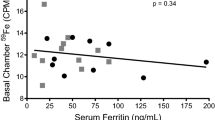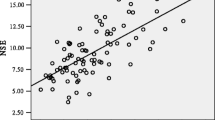Abstract
Objectives
Erythropoietin (EPO) was originally described as a regulator of erythropoiesis. Recently, synthesis of EPO and expression of the EPO receptor (EPO-R) have been reported for the central nervous system (CNS). The potential use of EPO to prevent or reduce CNS injury and the paucity of information regarding its entry into the human CNS led us to examine the pharmacokinetics (PK) of recombinant human EPO (r-HuEPO) in the serum and cerebrospinal fluid (CSF).
Methods
Four patients with Ommaya reservoirs were enrolled to facilitate serial CSF sampling. R-HuEPO was given intravenously (IV) in single doses of 40,000 IU or 1,500 IU/kg and in multiple doses of 40,000 IU daily for 3 days.
Results
The EPO concentrations in the CSF increased after a period of slow equilibration. Linear first-order distribution kinetics were observed for serum and CSF. The concentration of EPO in the CSF was proportional to the serum concentration of EPO and the permeability of the blood-brain barrier (BBB), as determined by the albumin quotient (QA=[albumin] CSF/[albumin] serum). A rise in the CSF concentration was seen as early as 3 h after IV administration. Peak levels (Cmax) were reached between 9 h and 24 h. After a single dose of 1,500 IU/kg, the Cmax in the CSF ranged from 11 mIU/ml to 40 mIU/ml, and the ratios of CSF/serum Cmax ranged from 3.6×10−4 to 10.2×10−4. The terminal half-life (t1/2) values of EPO in serum and CSF were similar. The t1/2 of r-HuEPO in the CSF ranged from 25.6 h to 35.5 h after a single dose of 1,500 IU/l. Using these parameters a PK model was generated that predicts the concentration-time profile of EPO in the CSF.
Conclusions
We report that r-HuEPO can cross the human BBB and describe for the first time the PK of EPO in the CSF after IV administration. Our data suggest that the concentration-time profile of EPO in the CSF can be predicted for individual patients if the serum concentration of EPO and the QA are known. This information may be useful in the design of clinical trials to explore the potential therapeutic effects of EPO during CNS injury.



Similar content being viewed by others
References
Masuda S, Okano M, Yamagishi K, Nagao M, Ueda M, Sasaki R (1994) A novel site of erythropoietin production. Oxygen-dependent production in cultured rat astrocytes. J Biol Chem 269:19488–19493
Juul SE, Anderson DK, Li Y, Christensen RD (1998) Erythropoietin and erythropoietin receptor in the developing human central nervous system. Pediatr Res 43:40–49
Dame C, Bartmann P, Wolber EM, Fahnenstich H, Hofmann D, Fandrey J (2000) Erythropoietin gene expression in different areas of the developing human nervous system. Brain Res Dev Brain Res 125:69–74
Digicaylioglu M, Bichet S, Marti HH, Wenger RH, Rivas LA, Bauer C, Gassmann M (1995) Localization of specific erythropoietin binding sites in defined areas of the mouse brain. Proc Natl Acad Sci U S A 92:3717–3720
Marti HH, Wenger RH, Rivas LA, Straumann U, Digicaylioglu M, Henn V, Yonekawa Y, Bauer C, Gassmann M (1996) Erythropoietin gene expression in human, monkey and murine brain. Eur J Neurosci 8:666–676
Morishita E, Masuda S, Nagao M, Yasuda Y, Sasaki R (1997) Erythropoietin receptor is expressed in rat hippocampal and cerebral cortical neurons, and erythropoietin prevents in vitro glutamate-induced neuronal death. Neuroscience 76:105–116
Juul SE, Stallings SA, Christensen RD (1999) Erythropoietin in the cerebrospinal fluid of neonates who sustained CNS injury. Pediatr Res 46:543–547
Bernaudin M, Marti HH, Roussel S, Divoux D, Nouvelot A, MacKenzie ET, Petit E (1999) A potential role for erythropoietin in focal permanent cerebral ischemia in mice. J Cereb Blood Flow Metab 9:643–651
Siren AL, Knerlich F, Poser W, Gleiter CH, Bruck W, Ehrenreich H (2001) Erythropoietin and erythropoietin receptor in human ischemic/hypoxic brain. Acta Neuropathol 101:271–276
Sakanaka M, Wen TC, Matsuda S, Masuda S, Morishita E, Nagao M, Sasaki R (1998) In vivo evidence that erythropoietin protects neurons from ischemic damage. Proc Natl Acad Sci U S A 95:4635–4640
Koshimura K, Murakami Y, Sohmiya M, Tanaka J, Kato Y (1999) Effects of erythropoietin on neuronal activity. J Neurochem 72:2565–2572
Sadamoto Y, Igase K, Sakanaka M, Sato K, Otsuka H, Sakaki S, Masuda S, Sasaki R (1998) Erythropoietin prevents place navigation disability and cortical infarction in rats with permanent occlusion of the middle cerebral artery. Biochem Biophys Res Commun 253:26–32
Brines ML, Ghezzi P, Keenan S, Agnello D, deLanerolle Nihal C, Cerami C., Itri LM, Cerami A (2000) Erythropoietin crosses the blood-brain barrier to protect against experimental brain injury. Proc Natl Acad Sci U S A 97:0526–10531
Ehrenreich H, Hasselblatt M, Dembowski C, Cepek L, Lewczuk P, Stiefel M, Rustenbeck HH, Breiter N, Jacob S, Knerlich F, Bohn M, Poser W, Ruther E, Kochen M, Gefeller O, Gleiter C, Wessel TC, DeRyck M, Itri L, Prange H, Cerami A, Brines M, Siren AL (2002) Erythropoietin therapy for acute stroke is both safe and beneficial. Mol Med 8:495–505
Buemi M, Allegra A, Corica F, Floccari F, D’Vella D, Aloisi C, Calapai G, Iacopino G, Frisina N (2000) Intravenous recombinant erythropoietin does not lead to an increase in cerebrospinal fluid erythropoietin concentration. Nephrol Dial Transplant 15:422–423
Cheung W, Minton N, Gunawardena K (2001) Pharmacokinetics and pharmacodynamics of epoetin alfa once weekly and three times weekly. Eur J Clin Pharmacol 57:411–418
Reiber H (1980) The discrimination between different blood-CSF barrier dysfunctions and inflammatory reactions of the CNS by a recent evaluation graph for the protein profile of cerebrospinal fluid. J Neurol 224:89–99
Grasso G, Buemi M, Alafaci C, Sfacteria A, Passalacqua M, Sturiale A, Calapai G, De Vico G, Piedimonte G, Salpietro FM, Tomasello F (2002) Beneficial effects of systemic administration of recombinant human erythropoietin in rabbits subjected to subarachnoid hemorrhage. PNAS 99:5627–5631
Farrel FX, Juul S, Elliot C, Anderson D, Jolliffe, LK (2001) Erythropoietin crosses the blood–brain barrier: an analysis in a nonhuman primate model. Blood 98:148b [abstract]
Jumbe NL (2002) Erythropoietic agents as neurotherapeutic agents: what barriers exist? Oncology 16(Suppl 10):S91–S107
Long JB, Holaday JW (1987) Blood–brain barrier: endogenous modulation by adrenal-cortical function. Science 227:1580–1583
Ziylan YZ, LeFauconnier JM, Bernard G, Bourre JM (1988) Effect of dexamethasone on transport of alpha-aminoisobutyric acid and sucrose across the blood-brain barrier. J Neurochem 51:1338–1342
Hedley-Whyte ET, Hsu DW (1986) Effect of dexamethasone on blood brain barrier in the normal mouse. Ann Neurol 19:373–377
McMahon FG, Vargas, R, Ryan M, Jain AK, Abels RI, Perry B, and Smith IL (1990) Pharmacokinetics and effects of recombinant human erythropoietin after intravenous and subcutaneous injections in healthy volunteers. Blood 76:1718–1722
Eprex Product Monograph. Revised version: April 1, 2002 p.23
Sowade B, Sowade O, Mocks J, Franke W, Warnke H (1998) The safety of treatment with recombinant human erythropoietin in clinical use: a review of controlled studies. Int J Mol Med 1:303–314
Acknowledgements
The authors wish to thank the participating patients for their genuine interest and time devoted to the study, and Drs. Ian Quirt and Warren Mason for their role as safety monitors. Project support was provided by an unrestricted grant from Ortho Biotech, Canada.
Author information
Authors and Affiliations
Corresponding author
Rights and permissions
About this article
Cite this article
Xenocostas, A., Cheung, W.K., Farrell, F. et al. The pharmacokinetics of erythropoietin in the cerebrospinal fluid after intravenous administration of recombinant human erythropoietin. Eur J Clin Pharmacol 61, 189–195 (2005). https://doi.org/10.1007/s00228-005-0896-7
Received:
Accepted:
Published:
Issue Date:
DOI: https://doi.org/10.1007/s00228-005-0896-7




